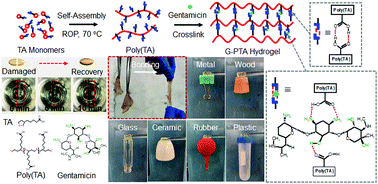A gentamicin-thioctic acid multifunctional hydrogel for accelerating infected wound healing†
Abstract
Bacterial infections remain a major concern during wound healing and tissue bonding. The excessive proliferation of bacteria will seriously hinder the repair of the wound and even lead to death. Generally, surgical sutures might cause damage to the surrounding tissues and inevitable infection due to the unfixed shape of the wound. Thus, it is urgent to develop novel antibacterial skin dressing with self-healing and strong adhesion properties. Herein, we prepared an antibacterial and self-healable hydrogel with strong adhesion activity through natural small molecules, including thioctic acid TA and gentamicin (GM). The rapid ring-opening-polymerization of the TA (PTA) forms the backbone of macromolecules, and the functional hydrogel was constructed with the crosslinking of GM, termed as G-PTA, which offers hydrogen bonding interactions between the amino and hydroxyl groups of GM and carboxylic group side chains of poly(TA). The synthesized hydrogel exhibited rapid self-healing ability and strong tissue adhesion due to the internal dynamic disulfide bonds and multiple hydrogen bonds. Importantly, the introduction of GM enabled the G-PTA hydrogel to sustainably release antibiotics and exhibit a durative antibacterial effect with the degradation of PTA, which further shorten the therapeutic time and enhance tissue regeneration in a wound infection model. The in vitro and in vivo experiments demonstrate that the G-PTA hydrogel has potential as a surgical antibacterial biological adhesive, especially for bacterial wound infections.



 Please wait while we load your content...
Please wait while we load your content...